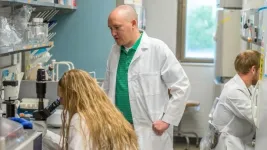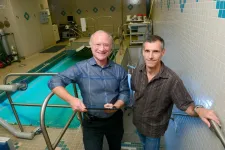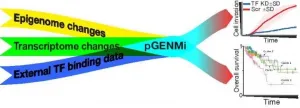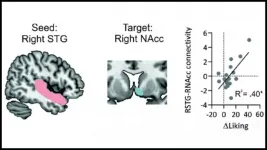Monkeys experience the visual world the same way people do
2021-03-29
(Press-News.org) When humans look out at a visual landscape like a sunset or a beautiful overlook, we experience something -- we have a conscious awareness of what that scene looks like. This awareness of the visual world around us is central to our everyday existence, but are humans the only species that experiences the world consciously? Or do other non-human animals have the same sort of conscious experience we do?
Scientists and philosophers have asked versions of this question for millennia, yet finding answers -- or even appropriate ways to ask the question -- has proved elusive. But a team of Yale researchers recently devised an ingenious way to try to solve this riddle.
Writing on March 29 in the Proceedings of the National Academy of Sciences, they make the case that one non-human species -- the rhesus macaque -- also has a conscious awareness of the world around it.
"People have wondered for a long time whether animals experience the world the way we do, but it's been difficult to figure out a good way to test this question empirically," said Moshe Shay Ben-Haim, a postdoctoral fellow at Yale and first author of the paper.
Researchers have known for a long time that people can be influenced by unconscious subliminal cues -- visual stimuli presented just outside of our threshold for conscious awareness, said Laurie Santos, a professor of psychology at Yale who is co-senior author of the study along with her colleague Steve Chang, associate professor of psychology and of neuroscience, and Ran Hassin of Hebrew University.
"We tend to show different patterns of learning when presented with subliminal stimuli than we do for consciously experienced, or supraliminal stimuli," she said.
If monkeys show the same "double dissociation" pattern that humans do, it would mean that monkeys probably experience the supraliminally presented stimuli in the same way as people do -- as a conscious visual experience.
Ben-Haim, Santos, and their team thought of a novel way to explore whether macaques also exhibit a difference in learning when stimuli are experienced consciously versus non-consciously.
In a series of experiments, they had monkeys and humans guess whether a target image would appear on the left or right side of a screen. Before the target appeared, participants received a visual cue -- a small star-- on the side opposite of where the target would subsequently appear. The researchers varied whether the cue was presented supraliminally or subliminally. When the cue was presented for a few seconds, human participants successfully learned that the target would appear in the opposite location from the cue. But when the cue was presented subliminally -- quickly enough that it escaped people's conscious perception -- participants showed a different pattern of performance; they continued to choose the side that was subliminally cued, failing to learn the rule that the cue predicted the opposite side.
Surprisingly, the researchers found that monkeys showed exactly the same response patterns as the people did: like humans, macaques were able to successfully look to the target location when the cues were presented consciously, but showed the reverse pattern for subliminal cues. This striking result suggests that monkeys have two levels of processing just as humans do, one of which must be conscious.
"These results show that at least one non-human animal exhibits both non-conscious perception as well as human-like conscious visual awareness." said Ben-Haim. "We now have a new non-verbal method for assessing whether other non-human creatures experience visual awareness in the same way as humans."
INFORMATION:
Other authors of the paper are Yarrow Dunham, Olga Dal-monte, and Nicholas Fagan of Yale.
ELSE PRESS RELEASES FROM THIS DATE:
2021-03-29
One specific protein may be a master regulator for changing how cancer cells consume nutrients from their environments, preventing cell death and increasing the likelihood the cancer could spread, a study from the University of Notre Dame has shown.
The study, published in Cell Reports, was completed in the laboratory of Zachary Schafer, the Coleman Foundation Associate Professor of Cancer Biology in the Department of Biological Sciences.
Schafer and collaborators found a protein called SGK1, known to be activated in a variety of cancer cell types, signals the ...
2021-03-29
LOS ALAMOS, N.M., March 29, 2021--A first-of-its-kind instrument that samples smoke from megafires and scans humidity will help researchers better understand the scale and long-term impact of fires--specifically how far and high the smoke will travel; when and where it will rain; and whether the wet smoke will warm the climate by absorbing sunlight.
"Smoke containing soot and other toxic particles from megafires can travel thousands of kilometers at high altitudes where winds are fast and air is dry," said Manvendra Dubey, a Los Alamos National Laboratory atmospheric scientist and co-author on a paper published last week in Aerosol Science and Technology. "These smoke-filled clouds can absorb ...
2021-03-29
Among patients who return to work after a heart attack, those who work more than 55 hours per week, compared to those working an average full-time job of 35-40 hours a week, increase their odds of having a second heart attack by about twofold, according to a prospective cohort study published today in the Journal of the American College of Cardiology.
Data from the International Labour Office estimates 1 in 5 workers worldwide work over 48 hours per week. Previous studies have found an association between working long hours and increased risk of coronary heart disease and stroke. This is the first study of its kind to examine the effect of long working hours and the risk of a second cardiovascular event ...
2021-03-29
Firearm injuries are a leading and preventable cause of injury and death among youth - responsible for an estimated 5,000 deaths and 22,000 non-fatal injury hospital visits each year in American kids. And while hospital systems are poised to tackle this issue using a public health approach, prevention efforts and policies may be differentially effective. A new study led by researchers at Children's National Hospital, finds that sociodemographic factors related to intent of injury by firearm may be useful in guiding policy and informing tailored interventions for the prevention of firearm injuries in at-risk youth.
"We sought to explore differences by injury intent in a ...
2021-03-29
DALLAS - March. 29, 2021 - With NASA preparing to send humans to Mars in the 2030s, researchers are studying the physical effects of spending long periods in space. Now a new study by scientists at UT Southwestern shows that the heart of an astronaut who spent nearly a year aboard the International Space Station shrank, even with regular exercise, although it continued to function well.
The results were comparable with what the researchers found in a long-distance swimmer who spent nearly half a year trying to cross the Pacific Ocean.
The study, published today in Circulation, reports that astronaut Scott Kelly, now retired, lost an average of 0.74 grams - about three-tenths of an ounce - per week in the mass ...
2021-03-29
Although the development of secondary cancerous growths, called metastasis, is the primary cause of death in most cancers, the cellular changes that drive it are poorly understood. In a new study, published in Genome Biology, researchers at the University of Illinois Urbana-Champaign have developed a new modeling approach to better understand how tumors become aggressive.
"Researchers have identified several cellular pathways that change when a tumor becomes aggressive. However, it is difficult to understand how they affect the tumor," said Steven Offer, an assistant professor of molecular pharmacology and experimental therapeutics at Mayo Clinic, Minnesota. "We wanted to develop a simple system that can model how cancer cells form ...
2021-03-29
FINDINGS
A new study by researchers at the UCLA Jonsson Comprehensive Cancer Center found using percutaneous image guided needle based thermal ablation -- the precise application of extreme heat or cold to a tumor using sophisticated ultrasound, CT or MRI in a single outpatient session -- is a safe and effective adjunctive therapy for the local control of metastatic gynecologic cancers throughout lungs, liver, soft tissues in the abdomen and pelvis and bones in patients with advanced localized cancers unresponsive to systemic therapy.
Nearly 96% of the patients in the study achieved a complete tumor response over a median follow up period of 10 months. The overall survival rate was 37.5 months and the progression-free ...
2021-03-29
BOSTON - In the last 20 years, Black adults living in rural areas of the United States have experienced high mortality rates due to diabetes, high blood pressure, heart disease and stroke compared to white adults. In a research letter written by colleagues at Beth Israel Deaconess Medical Center (BIDMC) and published in the END ...
2021-03-29
Age-related macular degeneration (AMD), which leads to a loss of central vision, is the most frequent cause of blindness in adults 50 years of age or older, affecting an estimated 196 million people worldwide. There is no cure, though treatment can slow the onset and preserve some vision.
Recently, however, researchers at the University of Rochester have made an important breakthrough in the quest for an AMD cure. Their first three-dimensional (3D) lab model mimics the part of the human retina affected in macular degeneration.
Their model combines stem cell-derived ...
2021-03-29
Communication between the brain's auditory and reward circuits is the reason why humans find music rewarding, according to new research published in JNeurosci.
Despite no obvious biological benefits, humans love music. Neuroimaging studies highlight similarities between how the brain's reward circuits process music and other rewards like food, money, and alcohol. Yet neuroimaging studies are correlational by nature. In a new study, Mas-Herrero et al. sought to nail down the causal role of this circuitry by using non-invasive brain stimulation.
A group of pop music fans listened ...
LAST 30 PRESS RELEASES:
[Press-News.org] Monkeys experience the visual world the same way people do





